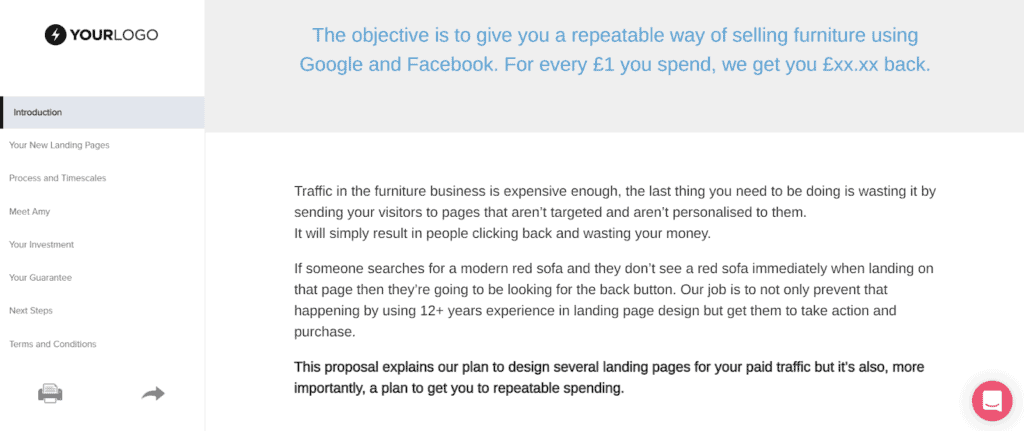
Acquiring new clients may be the hardest part of any designer’s job. As we sympathize with that, we have decided to give you a detailed tutorial on how to write an amazing design proposal that will help you win over the hearts of your clients.
Answering all your questions in one place, as well as sharing our favorite design template proposals, will surely get you right on your way to securing clients and winning over business deals.
As the last step in your effort to secure a new client, it’s your place to shine and present your services and yourself in the best possible way. If you had a fruitful discovery session, you already have a good foundation for your proposal.
It’s crucial to know what your client wants, why they chose you and what their long-term goals are. If you don’t know the answer to those questions, we suggest you organize a meeting before you start working on your proposal.
What is a design proposal?
The reason you’re writing a design proposal is to win the job. Sounds easy enough, right? A well-crafted proposal created with good proposal software will present your solution to your client’s problem, as well as a timeline, cost and even introduce them to some of your earlier work, without being too long and leaving your client feeling overwhelmed.

Start your proposal with an introduction, in which you’ll answer the following questions:
- what is the problem your client is currently facing
- why is it important to fix it with a high-quality solution and as fast as possible
End it with a quick overview of your proposed solution, which you’ll get into later on in the proposal.
4 top tips for writing a design proposal
To help you focus on the important aspects that need to be addressed in your proposal, we gathered the most frequently asked questions designers have about business proposals to clear things up for you.
Whether you’re getting hired to work on an entirely new website, app, or landing page, or to redesign an existing project, you’ll have to keep in mind the level of understanding of the subject matter that your client has. Don’t use technical jargon or terms that someone outside of your field of work wouldn’t understand.
Segmenting your target market could help you close the communication gap. For example, marketing to millennials has a different approach on the whole when trying to communicate with a mid to high aged segment.
Price your work clearly
The way you price your work won’t make or break your deal. However, it will impact the amount of money you will get as well as the ending date of any project you work on.
Let’s say that you charge by the hour. On one hand, you may feel that that’s the only way to ensure you never produce a piece of work you weren’t compensated for. On the other hand, you can only charge so much for 60 minutes of work, and having an hourly fee will not give you an incentive to finish your work quickly or before the deadline.
Another way to charge for your services is by a retainer. This entails working a set number of hours for a fixed monthly fee. This works for clients that have a large scope of work that needs to be done every month, so if you’re getting hired to design a lot of different projects, this can work for you.
On the other hand, if you’re going to work on one project, the best way to price your work is by value-based pricing. This entails a deep understanding of the end value of your work, as well as having enough experience to be able to prove your services bring value to your clients.
Knowing that a new website or a better site than they have now will bring more traffic to their site and result in more revenue is a huge factor that you have going for you when pleading your case. Make sure to present how investing in you now will bring in more revenue later by giving an ROI estimate.
Once you feel comfortable with the pricing choice, there is still the matter of presenting it. Our suggestion is to present it as a singular price, without creating different bundles, or trying to upsell your client. As our research shows, proposals with a single choice result in a 16,3% higher fee.

Source: Better Proposals
Talk about your self at the right moment
You may be tempted to start your proposal with a paragraph about how amazing you are, and why you’re the right choice for the job. However, this will feel redundant and it won’t accomplish the task at hand, which is to sell a solution to your client’s problem and not you.
As mentioned before, you should open your proposal with an emphasis on the solution you have for your client’s problem. Once you’ve covered that, and a chapter that goes more in detail on your design solution and timescales, you can insert a chapter in which you showcase your previous work and talk a bit about your experience and expertise.
You can include a short case study that focuses on ROI and all the benefits your clients experienced. If that seems like too big of a bite to take, try reaching out to your clients and ask for a review you can use in your proposal. Having an unbiased person pleading your case gives you authority and creates a sense of importance.
Set a tone
When you’re thinking of the tone you want to set, make sure not to start with placing blame on anyone. This is a mistake a lot of people make when they want to express the importance of their position, is that they try and blame someone within the company for not fixing the problem at hand sooner.
You definitely don’t need to go that route, just express that you know that they don’t have the time or expertise to work on the problem themselves and that they did the right thing by contacting you.
You want your client to feel excited to start working with you and excited about the future of your project, so make sure to confidently state your goals and talk about the future, instead of just focusing on the problem at hand.
Show them the bigger picture and all the possibilities that will open up once they have a new/redesigned site will give them confidence in your approach.
Submit the proposal
Once you write and design your proposal, make sure to end it with a call to action. That lets your client know that you’re ready to start working on the project and the only thing you need is their approval and a signed contract.
You can do this via email in which you’re sending your proposal, or you can include a chapter in your proposal that expands on the next steps. Depending on the way you decided to price your services, you can ask your client to pay your first fee and send you all the needed materials, like their brand book, logo, and other content.
If you don’t hear from your client for a few days, make sure to do a follow-up and ask them if they need any more details and if there is anything you can help them with.
4 design proposal templates
Now that we’ve covered all the important steps you need to take when writing your design proposal, here are some templates that can help you arrange your thoughts into a professional-looking proposal.
Aside from showcasing your solution, your proposal could also have an integrated payment solution as well as a singing option that turns it into a legally binding contract. You can do this with Better Proposal templates, which also allow you to track your client as they open your proposal and read through it.

Better Proposal’s free web design proposal template already has everything you need, from structure to content that you can easily customize to meet your needs.

For a more specialized template, you might want to try the WordPress website design proposal template which won $155 million worth of new business in 2020. Alternatively, you can try using Bidsketch’s proposal which is also free and comes with an ideal proposal pricing layout.

For all of you in the e-commerce business, you’ll love this free proposal that will help you showcase your expertise in the best way. This e-commerce web design proposal template can be customized to suit your client’s needs and once you create it, you will get a secure link that you can send to them, diminishing the need for sending through a PDF or printing out your proposal.

You don’t have to be a professional copywriter to create a great and easy-to-follow design proposal. Better Proposal’s landing page design template already comes with content you can easily change to input your case study or other proof of expertise.
The last tip we have for you is an important one. Don’t name your pricing chapter pricing, cost, or anything like that. This will invoke negative feelings in your clients, so name it investment or ROI instead.
Now that you read all of our tips and tricks and have a plethora of templates to choose from, you can start working on your proposal and be happily on your way to securing a new client.
About Petra Odak
Petra Odak is a Chief Marketing Officer at Better Proposals, simple yet incredibly powerful proposal software tool that helps you send high-converting, web-based business proposals in minutes. She's a solution-oriented marketing enthusiast with more than 5 years of experience in various fields of marketing and project management.
